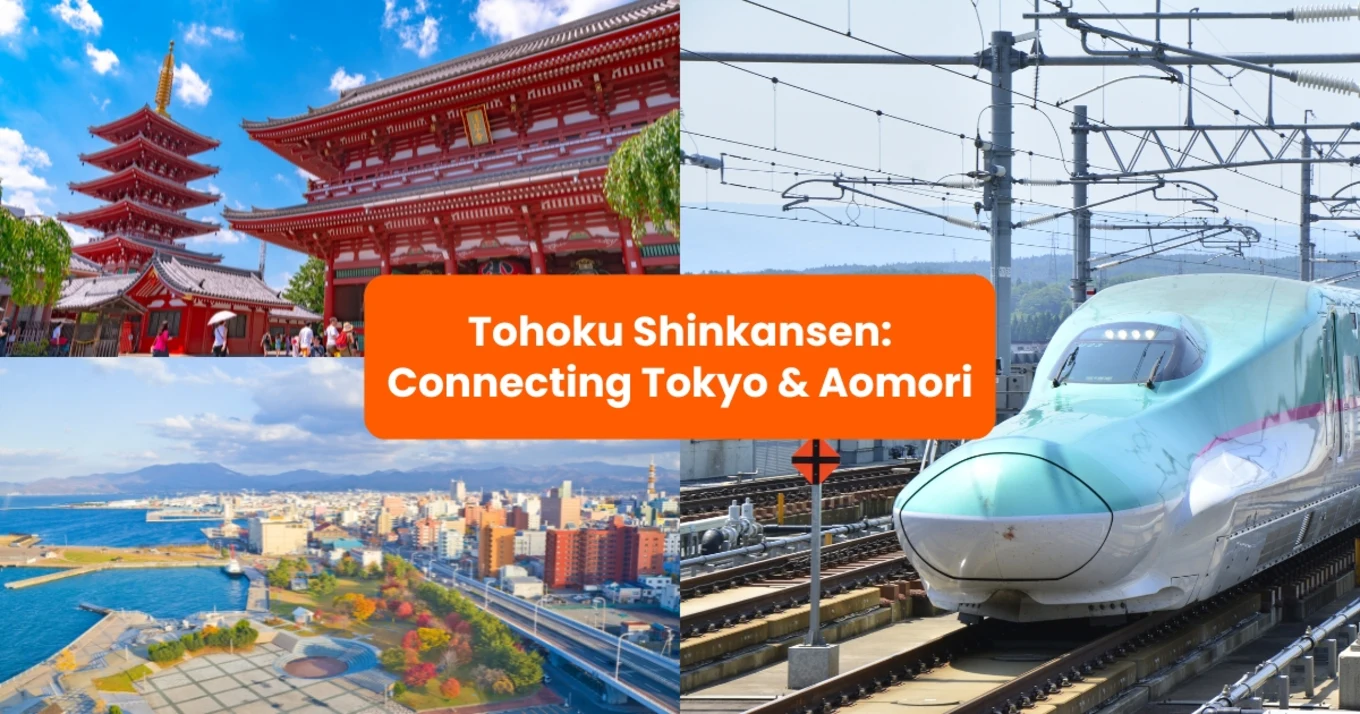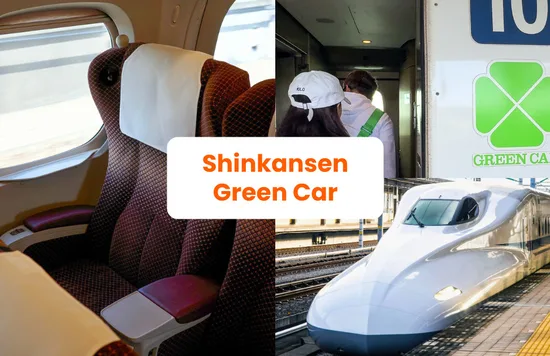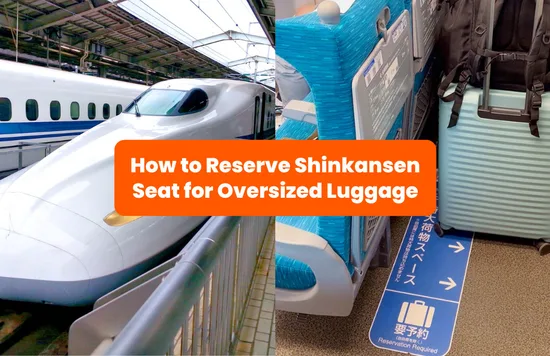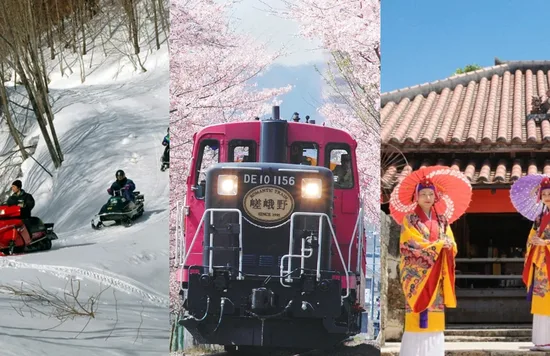Discover the Tohoku Shinkansen, Japan’s high-speed rail service that connects Tokyo with the northern regions of Honshu island.
This guide covers essential details like travel classes, speed, station navigation, and ticketing. Whether you’re planning a trip or simply curious about this engineering marvel, we’ll provide the information you need for a smooth journey on the Tohoku Shinkansen.
Tohoku Shinkansen Overview
- The Tohoku Shinkansen is a high-speed rail line connecting Tokyo with Aomori at the northern tip of Japan's main island, Honshu
- The Tohoku Shinkansen Line has two branch lines, also known as "mini Shinkansen lines" — the Akita and Yamagata Shinkansen which connect Tokyo to the Akita and Yamagata prefectures
- There are 6 train categories which run on the Tohoku Line: Hayabusa, Komachi, Hayate, Yamabiko, Nasuno, Tsubasa
- The JR East Pass offers unlimited rides on the Tohoku Shinkansen, making it an economical choice for tourists exploring the region
What is the Tohoku Shinkansen?
Connecting Tokyo to Aomori at the northern tip of Honshu, the Tohoku Shinkansen is a testament to Japan’s high-speed rail capabilities, offering a swift and comfortable journey across the country’s landscape.
It runs between Tokyo Station and Shin-Aomori Station, the longest distance of any line operated by East Japan Railway Company — covering nearly 675 km (420 miles).
Its track stretches up north, connecting with the Hokkaido Shinkansen line, and fans out with the Akita and Yamagata Shinkansen branch lines.
This high-speed corridor not only connects the country’s capital to the prefectures of Fukushima, Miyagi, Iwate, and Aomori but also serves as a gateway to the wonders of the Hokkaido Shinkansen. With major stops like Sendai Station, the cultural hub of Miyagi Prefecture, and Morioka Station, where the natural beauty of Iwate unveils itself, the Tohoku Shinkansen is a testament to Japan’s intricate blend of urban and rural landscapes.
Branch Lines: Akita and Yamagata Shinkansen
Diverging from the main artery of the Tohoku Shinkansen, the two branch lines Akita and Yamagata offer unique journeys into Japan’s verdant countryside.
These mini Shinkansen lines, starting from Tokyo Station, are an engineering feat, allowing standard gauge Shinkansen trains to travel on narrow-gauge tracks. The Akita Shinkansen unfurls its Komachi train service from Tokyo to Morioka, with trains continuing to serenade passengers with views of Akita’s rustic landscapes along the Akita Shinkansen branch line.
Meanwhile, the Yamagata Shinkansen line ushers travelers aboard the Tsubasa trains from Tokyo to Fukushima, before transitioning onto one of the two branch lines to reach Shinjo. These branch lines are not just transit routes; they’re threads connecting travelers to the cultural fabric of Tohoku.
Train Categories on the Tohoku Shinkansen
The Tohoku Shinkansen line boasts an impressive array of 6 train categories. All of them start at Tokyo Station, but stop at a different number of stations and terminate at different stations.
1) Hayabusa (Tokyo – Shin-Aomori)
The Hayabusa is not only the fastest train category on the Tohoku Shinkansen, it's the fastest train in Japan! Reaching a maximum speed of 320km/hr, it only stops at key stations such as Sendai, Ueno, and Morioka — meaning you can get from Tokyo to Shin-Aomori in just 189 minutes.
The Hayabusa is one of the few Shinkansens without non-reserved seating, so making a seat reservation in advance is mandatory. Standing tickets are available when all seats have been booked. The train has 10 cars — 8 Ordinary Cars, 1 Green Car, and 1 GranClass Car.
2) Yamabiko (Tokyo – Morioka)
After Hayabusa trains, Yamabiko is the next fastest train category, operating at 240km/hr. It has Ordinary Cars (both reserved and non-reserved seating), 1 Green Car and 1 GranClass Car.
3) Komachi (Tokyo – Akita)
The Komachi is the only train category on the Akita Shinkansen line. It has 7 cars, and unlike most Shinkansen trains, it only offers reserved seating (6 Ordinary Cars, 1 Green Car). As Komachi trains are narrower than regular Shinkansen trains, seats are in rows of 2 by 2.
4) Tsubasa (Tokyo – Shinjo)
The Komachi is the only train category on the Yamagata mini-Shinkansen line. It has 7 cars, and all are reserved seating (6 Ordinary Cars, 1 Green Car). As Tsubasa trains are narrower than regular Shinkansen trains, seats are in rows of 2 by 2.
5) Nasuno (Tokyo – Koriyama)
Nasuno trains are the slowest train category on the Tohoku Shinkansen. They cater to all stations from Tokyo to Koriyama, primarily serving daily commuters hailing from the prefectures of Fukushima and Tochigi. It is not necessary to make seat reservations on Nasuno trains.
6) Hayate (Tokyo – Morioka)
Hayate trains mainly terminate at Morioka. Unlike Yamabiko trains, they do not stop between Sendai and Omiya. Only reserved seating is available on Hayate trains.
With these 6 main services, the Tohoku Shinkansen accommodates various travel needs, making it a popular choice among residents and tourists alike.
Train Services and Class Options
The Tohoku Shinkansen line is renowned not only for its speed but also for its diverse range of train services that cater to the preferences and needs of every traveler.
Ordinary Car
Ordinary Cars on the Tohoku Shinkansen provide comfortable and efficient travel, with both reserved and non-reserved seating to accommodate the needs of all passengers.
Green Car
The Green Cars, with their spacious seating and additional amenities, are a nod to those seeking an elevated travel experience.
Gran Class Car
And for those who desire the pinnacle of luxury, the Gran Class car provides a sanctuary of comfort, complete with personalized service, gourmet bento boxes, and an array of beverages to savor as the landscape zips by. Amenities such as slippers and blankets are provided.
Key Stations on the Tohoku Shinkansen
The major stations of the Tohoku Shinkansen are more than just transit points; they are bustling hubs of activity and connectivity. These stations serve as gateways to the rest of Japan, allowing travelers to easily explore different regions.
The line’s major stations include:
- Tokyo Station: the line’s southern terminus, offering seamless transfers to countless destinations
- Ueno Station: a vital nerve center where travelers can hop aboard not only the Tohoku Shinkansen but also the Joetsu and Hokuriku Shinkansen lines
- Omiya Station: another important hub, providing connections to the Tohoku, Joetsu, and Hokuriku Shinkansen lines
- Utsunomiya Station : As the gateway to Nikko, Utsunomiya Station is the transportation center of Tochigi Prefecture and is famous throughout Japan for its delicious dumplings.
- Sendai Station: Sendai is the largest city in the Tohoku region. With a variety of transfer options to other JR lines, two subway lines, and local bus services, the station is the heartbeat of Miyagi Prefecture.
- Morioka Station : Morioka Station is the main station in Iwate Prefecture. It has a variety of local delicacies, such as Morioka cold noodles, Ishikari hot pot, etc., and is also a transportation hub to nearby famous hot springs and scenic spots.
- Fukushima Station: This station is a crucial node in the rail network, offering connections to the Yamagata Shinkansen, Tohoku Main Line, and the Fukushima Kotsu Iizaka Line. Passengers can embark on a journey to the historic town of Ouchijuku or the serene landscapes of Yamadera Temple, thanks to the direct Tsubasa Shinkansen services that link to the Yamagata branch line.
- Aomori Station : Aomori Station is the main station in Aomori City, and the Aomori Nebuta Festival every summer is a local cultural highlight. In addition, there are many apple orchards near the site where you can experience apple-picking.
Purchasing a single-trip ticket
You can easily purchase a single-trip ticket on Klook. A one-way ticket from Tokyo to Shin-Aomori on a Hayabusa train costs ¥16,620.
If you're planning to take multiple train rides including day trips, it might be more worthwhile to get the JR East Rail Pass (Tohoku JR Pass).
JR East Pass (Tohoku Area)
The JR East Rail Pass (Tohoku Area) is a rail pass specially designed for foreign passengers. This allows for unlimited rides on the Tohoku Shinkansen, Yamagata Shinkansen, and Akita Shinkansen for 5 consecutive days.
The Japan Rail East Pass offers many benefits for travelers, including:
- Limited express trains that directly run between the JR East lines and Tobu Railway lines: the Nikko, the SPACIA Nikko, the Kinugawa, and the SPACIA Kinugawa
- Tokyo Monorail
- Izu Kyuko Line
- Aoimori Railway Line
- Iwate Galaxy Railway (IGR) Line
- Sendai Airport Transit Line
- Tohoku Shinkansen, Akita Shinkansen, Yamagata Shinkansen, Jõetsu Shinkansen, and Hokuriku Shinkansen
- Reserved seats come at no extra cost
The JR East Rail Pass can be purchased online or at designated locations after arriving in Japan. We recommend purchasing tickets online in advance so that they can be used immediately upon arrival in Japan. It costs ¥30,000.
After completing the online ticket purchase on Klook, you will receive an electronic ticket exchange voucher. Head to a major JR East station (excluding Hachinohe and Mito Stations) and present the electronic ticket exchange voucher to receive a JR Pass and start visiting Tohoku attractions!
Frequently Asked Questions
Can I use the Japan Rail Pass on all Tohoku Shinkansen trains?
Yes, the Japan Rail Pass can be used on all Tohoku Shinkansen trains, including the Hayabusa trains, at no extra cost. So you can travel around freely without worrying about additional charges.
Do I need to reserve a seat on the Tohoku Shinkansen if I have oversized luggage?
Yes, if your luggage exceeds 160 cm in total dimensions, you're required to reserve a seat with a designated oversized baggage area to avoid potential extra charges.
Are there non-reserved seating options available on the Tohoku Shinkansen?
Yes, the Yamabiko service on the Tohoku Shinkansen offers both reserved and non-reserved seating options for flexibility.
What cultural attractions can I visit along the Tohoku Shinkansen route?
You can explore cultural attractions like Hirosaki Park, the National Omagari Fireworks Festival, Ouchijuku town, and Yamadera Temple along the Tohoku Shinkansen route.
Is there a direct connection from the Tohoku Shinkansen to the Hokkaido Shinkansen?
Yes, Shin-Aomori Station serves as the connecting point between the Tohoku Shinkansen and the Hokkaido Shinkansen for smooth transfers further north.
🇯🇵 Tokyo Travel Essentials 🇯🇵
Top things to do in Tokyo
- Day trips: Mt Fuji Instagrammable Spots | Mt Fuji and Hakone
- Visiting multiple attractions in Tokyo? Get the Klook Pass Greater Tokyo and enjoy up to 48% savings!
Getting around
Stay connected with our Japan 4G eSIM and find the best places to stay in Tokyo — plus exclusive hotel promos and bundle deals!
More Japan Inspiration
What is Klook?
Klook is Asia’s leading platform for experiences and travel services. We curate quality experiences ranging from attractions and tours to local transport and experiential stays, in over 2,700 destinations globally.
Browse our growing collection of travel activities and services in 15 languages, and complete bookings seamlessly with 40 currencies and over 40 payment methods.
Founded in 2014, we are here to inspire and enable more moments of joy for travelers anytime, anywhere. Whether it's something new in your neighborhood or an adventure abroad, with Klook you're always connected to a world of things to do and places to see.





























